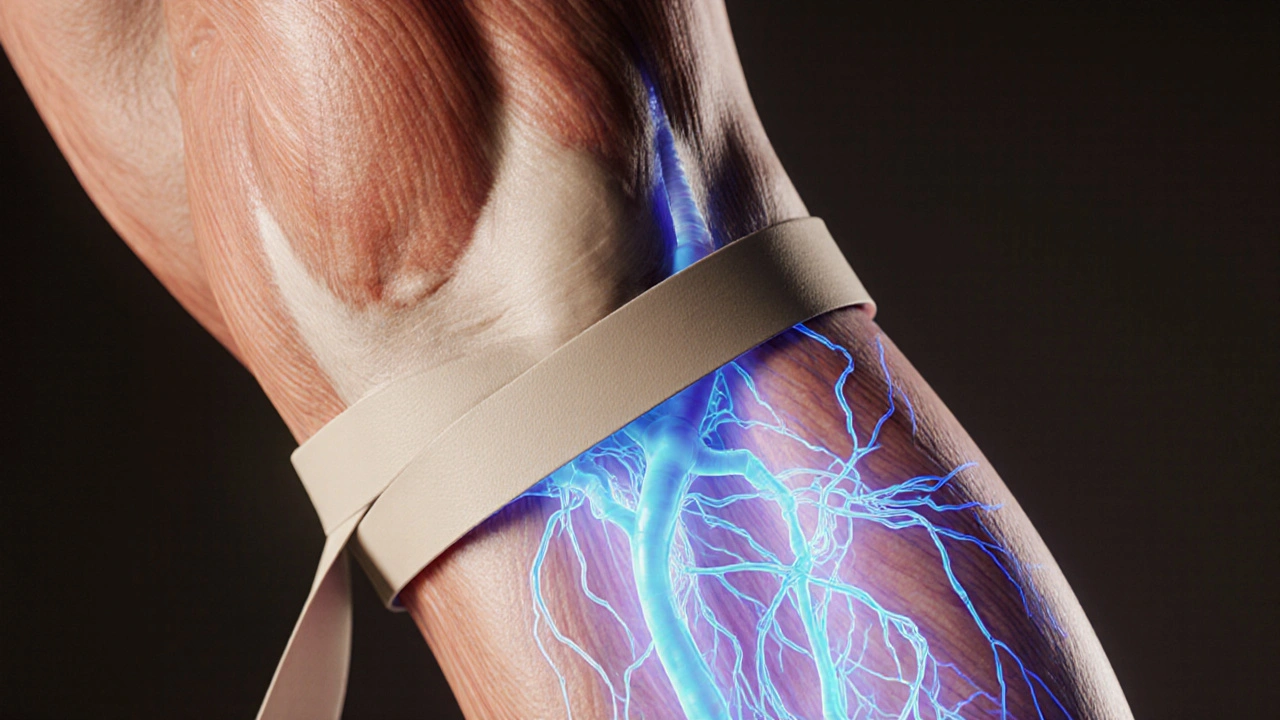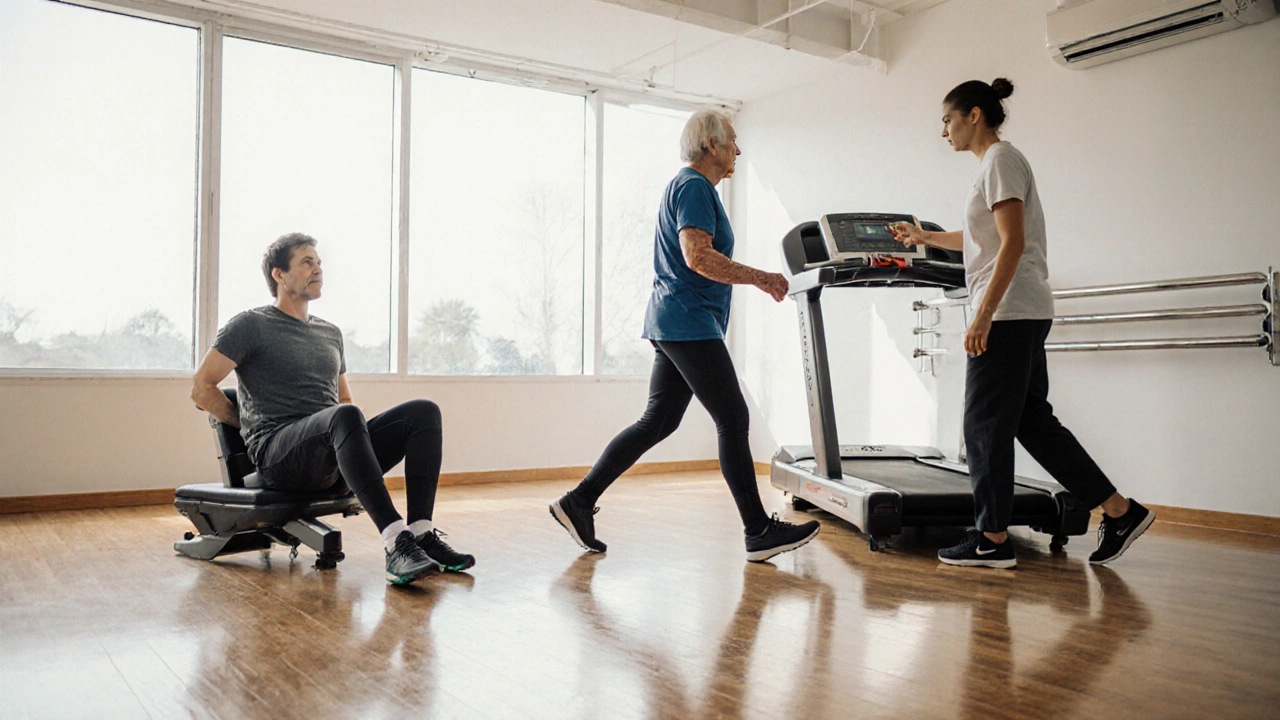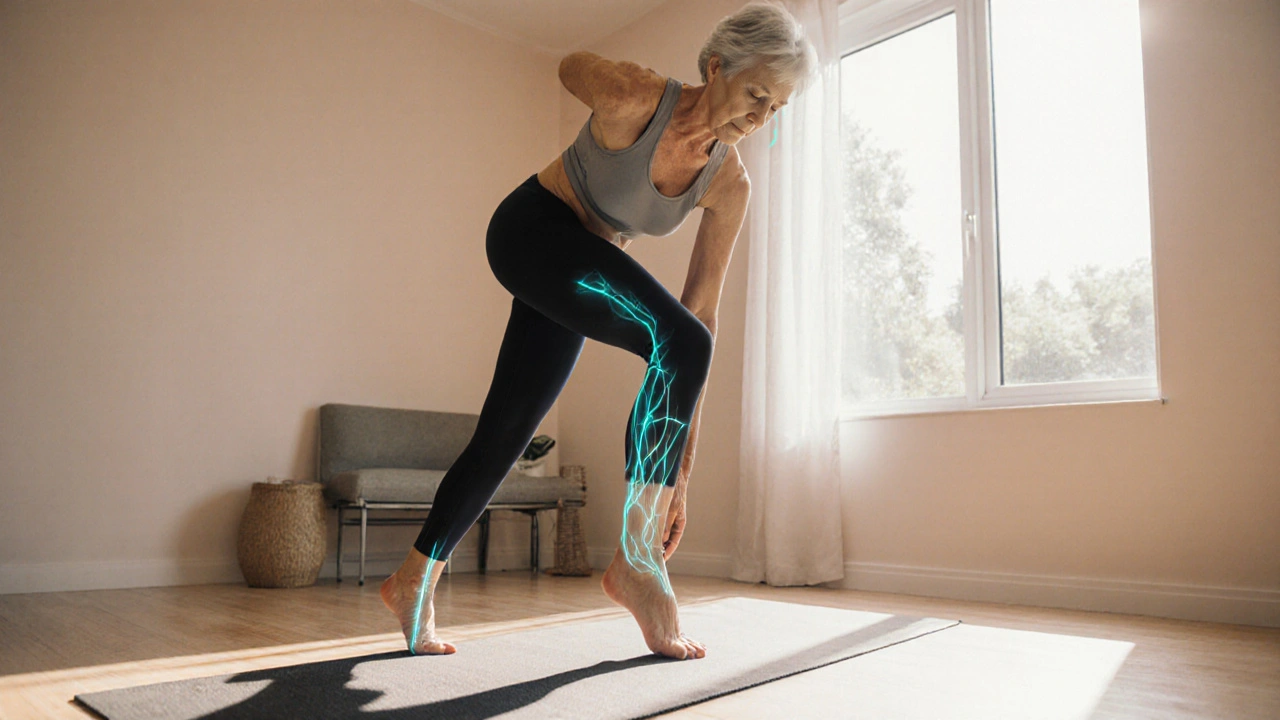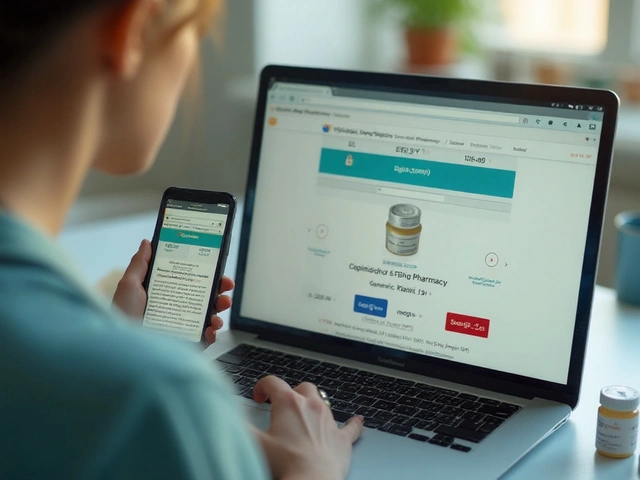Exercise is a planned, structured physical activity that improves or maintains fitness, stimulates circulation and activates the lymphatic system to move excess fluid out of tissue. When fluid builds up in the legs, arms or abdomen-a condition known as oedema-many people think rest is the answer. In reality, the opposite is true: gentle, regular movement is one of the most effective tools for both treating existing swelling and preventing it from returning.
What Is Oedema and Why It Happens
Oedema is a localized or generalized accumulation of interstitial fluid that causes visible swelling, heaviness and sometimes pain. It can arise from a range of causes-heart failure, chronic kidney disease, venous insufficiency, or even a high‑salt diet. The underlying problem is an imbalance between fluid filtration from blood vessels and drainage via the lymphatic system. When the drain can’t keep up, fluid pools and tissues swell.
How Exercise Impacts the Lymphatic System
Lymphatic system is a network of vessels and nodes that returns interstitial fluid to the circulatory system and helps clear metabolic waste. Muscle contractions generated by movement act like a pump, squeezing lymphatic vessels and propelling fluid toward the thoracic duct. Studies from the British Society of Sports Medicine show that just 30 minutes of moderate activity a day can improve lymph flow by up to 25% in people with chronic swelling. In practical terms, this means less puffiness, tighter skin and better joint mobility.
Types of Exercise Proven to Reduce Swelling
Not all workouts are created equal when it comes to tackling oedema. Three broad categories have the strongest evidence base.
| Exercise Type | Typical Intensity | Primary Benefit for Oedema | Suggested Session Length |
|---|---|---|---|
| Cardiovascular exercise | Low‑to‑moderate (walking, cycling) | Boosts heart rate and venous return, reducing fluid pooling | 20‑30minutes, 3‑5 times/week |
| Resistance training | Moderate (body‑weight, elastic bands) | Strengthens calf‑muscle pump, enhancing lymphatic drainage | 10‑15minutes, 2‑3 times/week |
| Aquatic therapy | Low (water walking, gentle strokes) | Water pressure supports limbs, while movement drives fluid out | 30‑45minutes, 2‑4 times/week |
Designing a Safe Exercise Routine for Oedema Patients
- Start with gentle warm‑up: ankle circles, seated marching for 5minutes.
- Choose a primary modality (e.g., walking) and keep the pace comfortable-you should be able to speak in full sentences.
- Add a brief strength block: 2‑3 sets of 10‑15 heel raises or wall squats.
- Focus on the calf‑muscle pump; this directly assists venous return.
- Finish with a cool‑down and gentle stretch to avoid sudden blood pooling.
- Log your session: time, perceived effort, and any change in limb circumference.
Consistency beats intensity. Even a 10‑minute daily walk can outperform a once‑a‑month marathon when the goal is fluid control.

Complementary Therapies: When Exercise Works With Compression and Physical Therapy
Compression therapy is a non‑pharmacological method that applies graduated pressure to limbs, encouraging venous and lymphatic return. Pairing compression stockings with a post‑walk leg‑raise routine can cut swelling by an additional 15% according to a 2023 NICE guideline. Likewise, Physical therapy is a hands‑on treatment that includes manual lymph drainage, mobility drills and education. A therapist can tailor the exercise intensity to the patient’s current fluid load, preventing over‑exertion that might worsen oedema.
Special Considerations for Common Underlying Conditions
Oedema often co‑exists with chronic diseases. Each condition shapes the exercise prescription.
- Heart failure: Focus on low‑impact cardio (e.g., recumbent cycling) to avoid sudden spikes in blood pressure.
- Chronic kidney disease: Monitor sodium intake and keep sessions under 30minutes to reduce strain on the kidneys.
- Diabetes: Incorporate foot‑care checks before and after activity to prevent ulceration.
When in doubt, involve the treating physician or a specialist nurse to ensure the programme matches the medical plan.
Monitoring Progress and Knowing When to Adjust
Objective measures keep you honest. Use a flexible tape to record calf or ankle circumference at the same time of day (typically morning). A reduction of 1‑2cm over two weeks usually signals that the routine is effective.
If swelling worsens despite adherence, consider these triggers:
- Excessive salt or fluid intake.
- Sudden increase in exercise intensity.
- New medication (e.g., calcium channel blockers) that can promote fluid retention.
Adjust by dialing back duration, adding an extra compression session, or consulting a physiotherapist for technique tweaks.
Bottom Line: Putting It All Together
When you combine exercise oedema treatment with smart compression, regular monitoring and condition‑specific tweaks, swelling becomes manageable rather than inevitable. Start small, stay consistent, and let the body’s own pumps do the heavy lifting. Over weeks, you’ll notice lighter limbs, improved mobility, and a brighter outlook on everyday life.

Frequently Asked Questions
Can I exercise if I have severe leg swelling?
Yes, but keep the activity low‑impact and short. Start with seated leg lifts or water walking, then gradually increase duration as tolerance improves. Always check with your doctor before beginning.
How often should I measure my limb circumference?
Measure twice a week, preferably in the morning before any activity. Consistent timing reduces variability caused by daily fluid shifts.
Is resistance training safe for people with heart failure?
When prescribed by a cardiac rehab specialist, light resistance work (e.g., elastic bands) is safe and can actually improve venous return. Avoid heavy lifts and breath‑holding.
Do compression stockings replace the need for exercise?
No. Compression supports fluid movement, but muscle activity is essential to drive the lymphatic pump. The best results come from using both together.
What’s the role of diet in oedema management?
Limiting salt to under 2g per day and staying hydrated helps prevent fluid retention. Pairing a balanced diet with regular movement gives the clearest path to reduced swelling.







Comments
Persephone McNair
The mechanistic underpinnings of lymphatic propulsion are often oversimplified; what you’re really looking at is a dynamic hydrostatic gradient modulated by skeletal muscle shear forces.
In the context of oedema, the interplay between venous return and interstitial oncotic pressure becomes critical.
Your routine should therefore integrate proprioceptive feedback loops to optimize pump efficiency.
Neglecting the microvascular compliance factor undermines any superficial gain.
Consider calibrating intensity based on real‑time biofeedback metrics.
siddharth singh
First and foremost, let me state unequivocally that a disciplined, moderate‑intensity exercise regimen is not merely beneficial but essential for anyone dealing with chronic oedema, and that assertion is backed by a substantial body of peer‑reviewed literature.
When you engage in low‑to‑moderate cardiovascular activities such as brisk walking or gentle cycling, you activate the calf‑muscle pump, which in turn augments venous return and concomitantly reduces hydrostatic pressure within the capillary beds.
Simultaneously, incorporating resistance training using elastic bands or body‑weight exercises fortifies the skeletal muscles that surround the lymphatic vessels, thereby enhancing the intrinsic lymphatic contractility that is often compromised in oedema patients.
It is crucial to maintain a training frequency of at least three sessions per week, each lasting between twenty and thirty minutes, because consistency outperforms sporadic high‑intensity bouts in terms of fluid redistribution.
Moreover, the timing of your workouts relative to meals can influence outcomes; exercising shortly after a low‑salt meal can mitigate post‑prandial fluid shifts that exacerbate swelling.
Hydration status also plays a non‑trivial role, as both dehydration and over‑hydration can destabilize plasma oncotic pressure, so aim for a balanced intake of approximately 2‑3 liters of water per day, adjusted for individual renal function.
In patients with comorbid heart failure, a recumbent bike or aquatic therapy may be preferable to weight‑bearing activities, as these modalities lower myocardial demand while still stimulating circulatory dynamics.
For those on diuretics, coordinating exercise sessions with medication timing can prevent orthostatic hypotension, a common pitfall in this population.
Monitoring limb circumference twice weekly with a flexible tape provides an objective metric to gauge progress; a reduction of one to two centimeters over a fortnight typically signals therapeutic efficacy.
If you observe a plateau or worsening edema despite adherence, reassess your salt intake, verify that you are not inadvertently increasing exercise intensity too rapidly, and consider adding compression therapy as an adjunct.
Compression stockings, particularly those with graduated pressure gradients, can synergize with muscular activity by providing external support that facilitates venous and lymphatic flow.
It is also advisable to keep a detailed log of each session, noting perceived exertion, any pain or discomfort, and changes in limb measurements, as this data can be invaluable for clinicians tailoring your program.
Do not overlook the importance of proper footwear; ill‑fitting shoes can impede gait mechanics and thus diminish the effectiveness of the calf‑pump action.
Finally, remember that psychological factors such as stress can influence hormonal pathways that affect fluid balance, so incorporating relaxation techniques alongside physical activity can confer additional benefits.
In sum, a holistic approach that blends regular, moderate exercise, vigilant monitoring, appropriate compression, and dietary moderation constitutes the most robust strategy for managing and preventing oedema.
Crystal Price
Honestly, if you think all this exercise thing is a hype, you’re missing the point entirely.
People who ignore simple movement are just setting themselves up for endless swelling and frustration.
It’s not rocket science – walk, lift a little, keep the blood moving.
Anything less and you’ll keep feeling heavy and stuck.
Murhari Patil
They don’t tell you that the “real” agenda behind these guidelines is to keep you hooked on wearable tech and data apps – it’s all a control mechanism.
Every step you take is monitored, every heartbeat logged, and the industry profits while you think you’re healing.
Just be careful not to become a pawn in their data‑driven experiment.
kevin joyce
From a systems‑level perspective, one can view the lymphatic network as a quasi‑vascular organ whose functional homeostasis is contingent upon the rhythmic contractile activity of surrounding musculature.
Thus, integrating biomechanically synergistic exercises not only reconditions the myofascial envelope but also reinstates the intrinsic peristaltic propulsion of interstitial fluid.
In practical terms, think of each heel‑raise or low‑impact march as a microscopic pump stroke, cumulatively amplifying lymphatic drainage.
When this is coupled with judicious compression gradients, the resultant pressure differential optimizes transmural fluid exchange, thereby attenuating edema formation.
Jamie Balish
Hey everyone, let’s take a moment to celebrate the small victories we’ve already seen in our journeys!
Starting with just five minutes of gentle marching each morning can set a positive tone for the whole day and gradually build the muscle memory needed for more robust sessions.
Remember to breathe deeply during each movement – the diaphragm acts like a secondary pump, further encouraging lymph flow.
If you ever feel a twinge of doubt, picture the swelling receding like the tide, one gentle wave at a time.
Stay consistent, celebrate progress, and keep cheering each other on – we’re all in this together, and your persistence truly makes a difference!
Jeff Bellingham
While informative, the article could benefit from more rigorous citation of primary studies.
Matthew Balbuena
Yo, love the vibes here! Just a heads up – you can totally swap those heel raises for some fun dance moves in your living room, it’s still a solid calf pump and way more exciting.
Also, don’t forget to stay hydrated, but don’t go overboard – no one wants a water‑logged feeling.
Keep the log simple – maybe just a quick note on your phone, you’ll thank yourself later when you see the progress chart!
michael abrefa busia
Great breakdown! 👍💪 Keep moving and the swelling will shrink.
Bansari Patel
Listen, the science is clear – you either put in the work or you stay swoll and miserable, no middle ground.
If you’re serious, crank up that cardio and stop making excuses, because the body will punish you for every lazy moment.
Rebecca Fuentes
Thank you for presenting the information in such a structured manner. It is particularly helpful for individuals navigating multiple comorbidities, as the nuanced recommendations can be readily adapted to diverse clinical contexts.
Jacqueline D Greenberg
Hey, just wanted to say I totally get how overwhelming all this can feel, especially when you’re battling swelling on top of everything else.
If it helps, try setting a tiny, realistic goal – like a five‑minute walk after breakfast – and celebrate every single step you take toward feeling a bit lighter.
We’re all rooting for you, and every bit of movement counts.
Jim MacMillan
While the recommendations are sound, let’s not forget that elite athletes have long leveraged periodized training to fine‑tune fluid dynamics – a concept worth exploring beyond the basics. 😏🏆
Dorothy Anne
Keep pushing forward, even on the days when the legs feel heavy – each step is a win, and the momentum you build will pay off in clearer, lighter limbs.
Sharon Bruce
Our nation deserves strong, healthy citizens; let’s prioritize movement and show our resilience! 🇺🇸💪
Brufsky Oxford
Reflecting on the interconnectedness of muscular activity and lymphatic flow reminds us that the body is a harmonious system; every gentle contraction echoes a larger symphony of health. :)
cris wasala
Stay positive keep moving you’ll see results soon